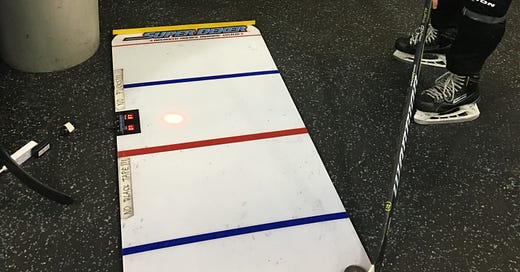Concussions are one of the most consequential issues in contact sports, and, unfortunately, that includes hockey.
While not a credentialed expert, we’ve done enough deep dives and had many conversations with people smarter than us. We want to pass along what we have learned.
What is a concussion?
From the CDC:
A concussion is a type of traumatic brain injury—or TBI—caused by a bump, blow, or jolt to the head or by a hit to the body that causes the head and brain to move rapidly back and forth. This sudden movement can cause the brain to bounce around or twist in the skull, creating chemical changes in the brain and sometimes stretching and damaging brain cells.
While most people associate concussions with violent contact, concussions aren’t always a result of large and obvious situations. More on this below.
Symptoms can be physical, cognitive, or emotional. All three areas can give us symptoms that can clue people into the fact that someone has a concussion.
Equipment Protection
Hockey Helmets
While helmets are important and effective against head injuries, they are not very effective against brain injuries.
This is a large reason why changes in rules and the way rules are enforced are important to modify what is considered normal behavior to reduce concussions.
Mouthguards
While facemasks and mouthguards are effective at preventing facial and dental (and tongue) injuries, they have not been scientifically proven to be effective against concussions.
The Main Cause of Concussions
When looking into this issue over the past few years, we’ve come to understand that the research is pointing toward unexpected contact as the main reason for concussions.
If a player can see the contact coming, they are usually able to brace for contact effectively and minimize concussion risk to the best of their ability. Even if the contact is a massive high-force body check.
Avoiding Unexpected Contact
While avoiding contact is preferred, in a contact sport like ice hockey, it is not realistic to avoid 100% of contact. The ability to see contact or understand it is coming is of vital importance.
Playing “heads up” or “aware” hockey is a key component to staying safe on the ice. Especially within concussion avoidance and minimalization. The ability to see the ice is paramount to keeping players safe while playing.
Putting a focus on ice awareness should be a major priority for any parent, coach, player, and any reasonable hockey person. Where should we start?
Puck competency
All players can easily shoulder check/look around/scan without the puck to acquire ice awareness.
With the puck on their stick, the biggest correlation to ice awareness, and therefore concussion avoidance and prevention, is puck competency.
Puck competency, simply put, is the ability to confidently handle the puck.
While many people approach having great puckhandling/stickhandling ability from a playing ability standpoint, we believe that what is underrated is the fact that great puckhandling ability also plays into reducing injuries such as concussions.
SuperDeker
We spent hours in our youth working on stickhandling. Whether playing knee hockey, road hockey, pick-up hockey, or stick and puck at the local rink. Now kids are using technology to work on their puck competency with stickhandling mats.
We’ve recently connected with the folks at SuperDeker to be a sponsor of our newsletter and podcast. With this, they have an offer of $25 off by using the link below (applied at checkout).
Personally, we’ve used the SuperDeker with our teams. It’s a fun way to compete and work on puckhandling ability.
Further Reading
Did you enjoy this newsletter?
Help us spread the ideas within and share it with the people you care about



